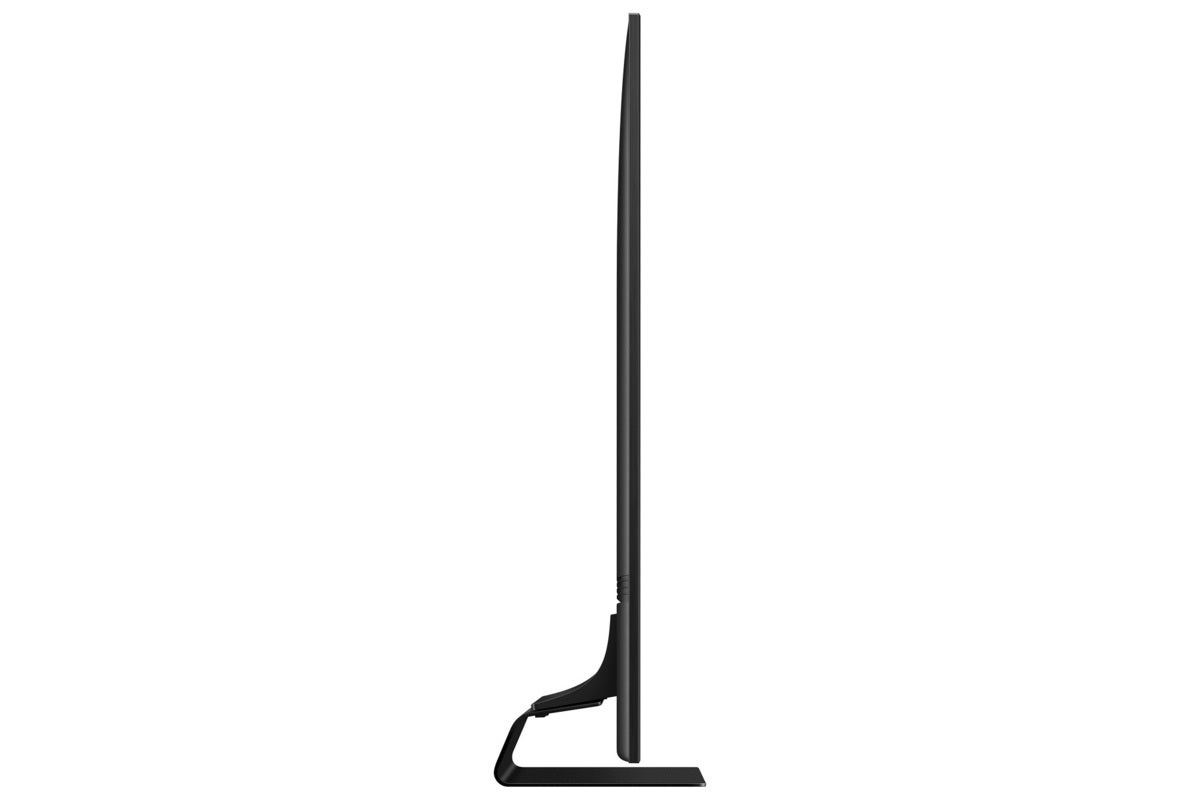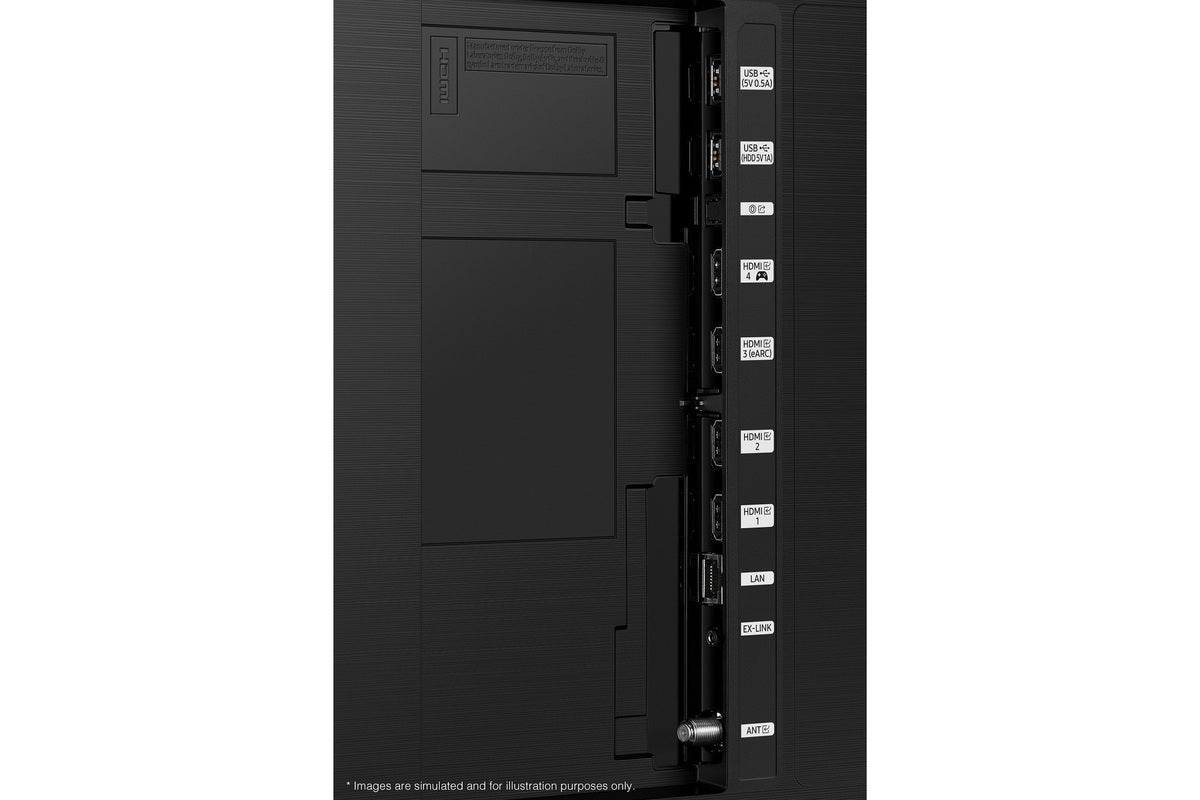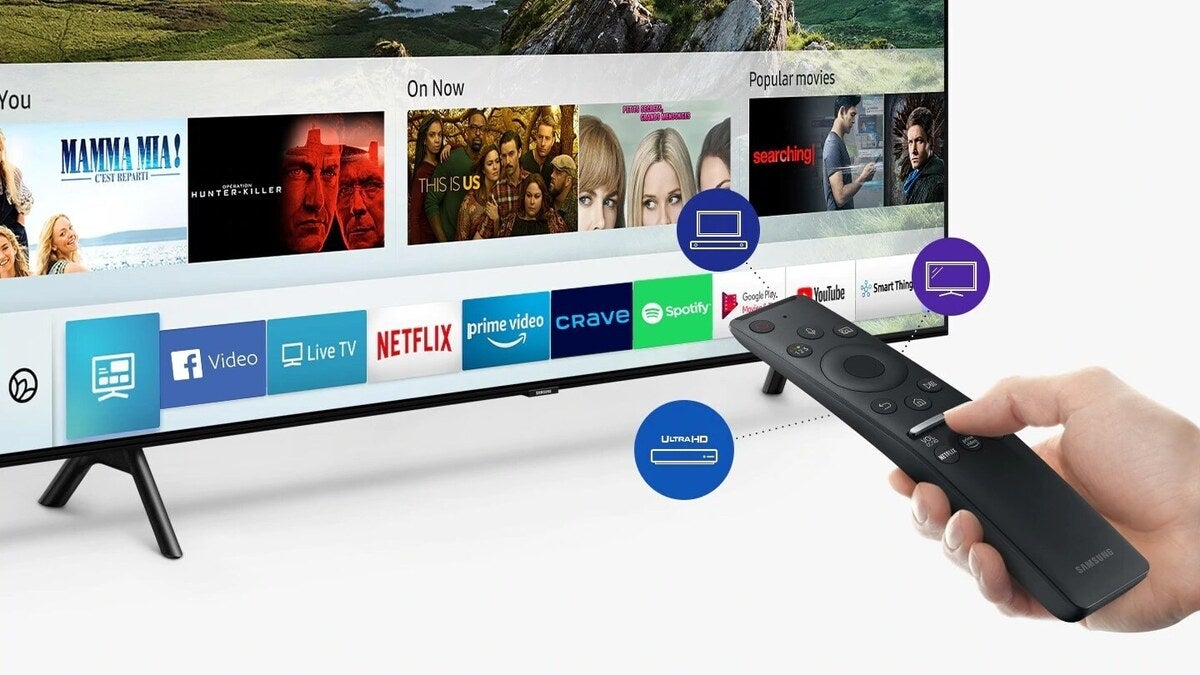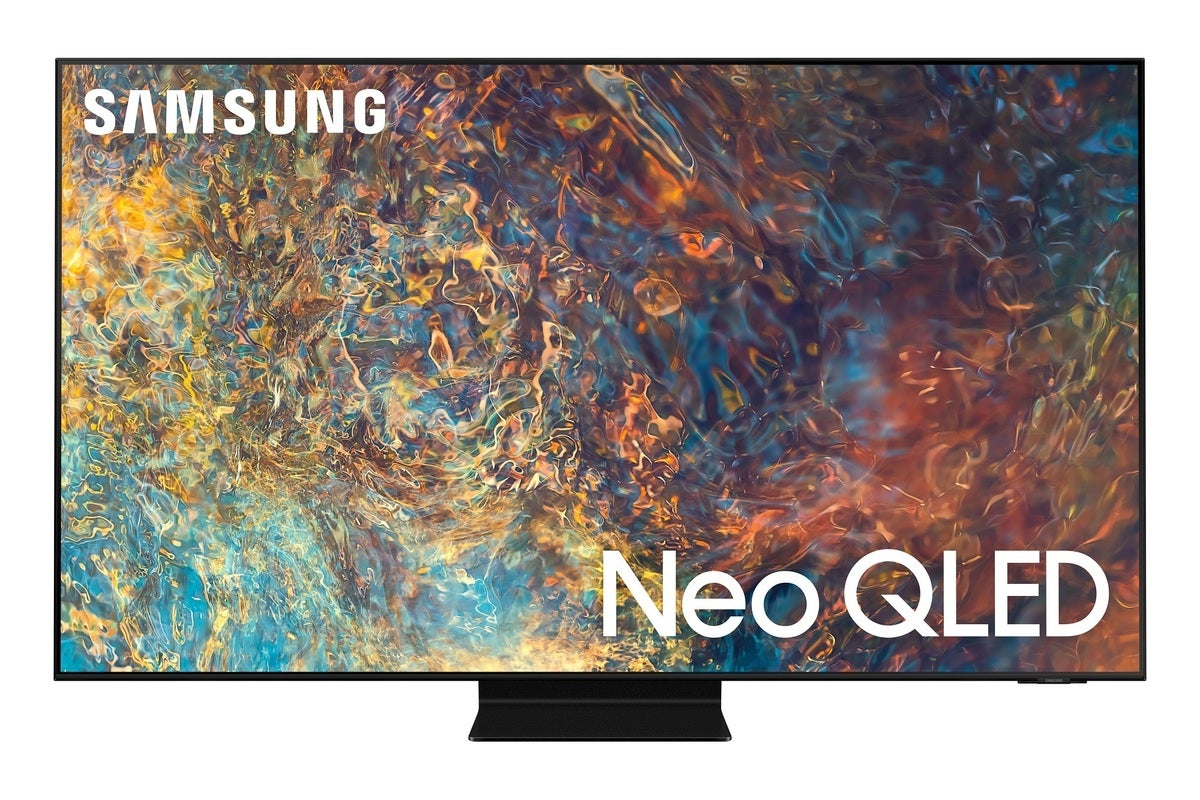Samsung’s Neo QLED QN90A takes the company’s already outstanding QLED color and brightness and, thanks to far more granular mini-LED backlighting, enhances it with far better blacks. The overall result is truly impressive, although Samsung still has some work to do on its zone dimming techniques.
Design and features
The 54.6-inch (55-inch class) version of the QN90A I tested currently retails for around $1,700 and features a 4K UHD (3840 x 2160), 120Hz, 10-bit display. Said display implements quantum dots for accurate, saturated color, and mini-LEDs for refined backlighting.
Mini-LEDs, as you might guess, are far smaller than traditional backlight LEDs. They’re placed closer to the filter/LCD layers to increase brightness and reduce bleed. And because they’re employed in far greater numbers, they also allow more precise zone dimming. How precise depends on the number of zones the vendor decides to divvy them into. In the case of the 55-inch QN90A, that seems to be around 600. QN90A models with larger screen sizes likely use more.
This review is part of TechHive’s coverage of the best smart TVs, where you’ll find reviews of the competition’s offerings, plus a buyer’s guide to the features you should consider when shopping for this type of product.
The QN90A comes with the same iMac-like pedestal that we first saw from Samsung a year or so ago. It adds quite a bit of weight (9.3 pounds), but that’s necessary for for stability. The classy appearance and ability to sit on smaller surfaces are well worth it.
Including stand, the unit weighs 48.3 pounds; without it, 39 pounds. The QN90A is also remarkably thin at just one inch, which makes it look nice on the wall. To that end, a 200mm VESA mount point is integrated. You can see just how thin the TV is in the image below. The part jutting out from the back is part of the stand, not the TV itself.
 Samsung
SamsungSamsung’s QN90A is only 1-inch thick, despite not employing the One Connect breakout box that the company was so fond of a year or two ago.
The port selection on the QN90A is modern, though extremely shy on legacy support. There’s no composite, no component, no analog audio in or out—not even a headphone jack. While the latter might seem quaint in the age of Bluetooth, it can be very handy when your headphone batteries die in the middle of a movie. If you need analog connections, you’ll need to purchase an HDMI converter.
The new stuff includes four HDMI ports on the TV itself. Three are mainly HDMI 2.0, with one being 2.1 to support 120Hz sources. Another supports eARC. In case you weren’t aware, vendors can implement individual elements of the 2.1 spec as they desire.
There are also two USB 2.0 ports (for mass storage, a keyboard, or other devices), coax for cable/satellite TV connections or an over-the-air antenna, ethernet, digital optical (Toslink) out, and an RS-232C (EX-Link, in Samsung terminology) port for customized remote control). Wireless connectivity is is via 802.1ac (Wi-Fi 5) and Bluetooth 4.2. Bluetooth audio devices are supported.
Samsung supports Amazon Alexa and Google Assistant, as well as it’s own Bixby voice assistant. Other technologies onboard include Apple AirPlay 2; HDR10, HDR10+, and HLG (no Dolby Vision); plus Dolby Atmos and DTS:X.
There’s also a channel guide, a universal guide for all content (smart TV streaming), as well as unique Samsung features such as Health and free, curated content in TV Plus. If over-the-air—aka broadcast—content isn’t cutting it that day, TV Plus might tide you over.
Variable refresh rate, auto low latency, and Freesync Premium Pro are on board for gaming. Consoles connect to HDMI input number four. The QN90A also sports both Filmmaker and IMAX Enhanced video modes.
 Samsung
SamsungSamsung provides all the modern ports; but apart from RS-232c, there are no legacy connections—not even analog audio.
Samsun
With all that, you wouldn’t expect the QN90A to be cheap, and being Samsung’s current top-of-the-line 4K UHD TV, it isn’t. Aside from the $1,700, 55-inch I reviewed, there are 50-, 65-, 75-, and 85-inch flavors selling for $1,500, $2,600, $3,500, and $5,000 respectively.
Remote and interface
The QN90A uses the newly revamped TM2180E universal remote control, which features a solar panel on the back for charging. There’s also a USB-C charging port should there be insufficient light available. It features the same minimalist layout as Samsung’s other remotes and has the same clever, dual-action (press forward, back, or down) channel-change and volume-control buttons.
 Samsung
SamsungSamsung’s new solar-powered One Remote. There’s a solar panel on the back, but you can charge it via USB-C if you’re living in a bunker.
Samsung’s Smart Hub interface, with its home row of icons that branch into related functions, is also attractive. As nice as it is to look at, and as seamless as it marries with the remote, the result is actually not very efficient.
It generally takes several button clicks to do what most remote/interface systems will do in one or two; largely because you’re constantly drilling down through dialogs to reach various settings.
Additionally, pressing Home takes you back to the same place on the icon list every time. A more efficient apporach would take you to your last-used location. And while I appreciate offers to reconnect to the last-used Bluetooth device, it would be nice if it only did so when it senses the device is available. Better yet, just reconnect.
 Samsung
SamsungSamsung’s Smart Hub and minimalist remote (a non-solar version is shown) look great, but they’re synergy is weirdly inefficient. A couple more buttons on the remote, and less tunneling in the interface would work wonders.
I watch movies streamed from a NAS box, and Smart Hub would remove the icon for that box from the home row whenever it couldn’t detect it (this happens to any source connected to the TV). The DLNA app automatically plays any subtitles it finds, even when they’re the same language, and there’s no way that I could find to turn this off; instead, I had to hit the TV’s settings menu and manually turn them off.
Also, unlike Roku’s media player, which remembers the last location for every recently viewed movie, Samsung’s player only occasionally picks up where I left off viewing. And everything is lost when it loses track of the DLNA server on the NAS box.
I’m of course being picky, and not a lot of users stream from sources on their home network, but those nits are symptomatic of the interface in general. Samsung should really backseat style and compartmentalization in favor of efficiency and convenience. In other words, fewer clicks, please.
Picture and sound
The QN90A offers up arguably the most vivid image I’ve seen on an LED-backlit LCD TV. Vivid, as in bright with highly saturated and accurate color and excellent contrast. It’s akin to OLED, with not quite the same inky blacks, but a lot more brightness to counterbalance: almost 2,000 nits peak in Dynamic mode. Yowser.
There are the aspects I’ve already praised, but the QN90A also delivers very smooth motion, an insane amount of configurability (including color tweaking and motion-related functions), excellent screen uniformity (no cloudy areas), and minimal moiré and processing artifacts. Viewing angles are also outstanding.
But given that the QN90A is a high-end, pricey TV, the backlight performance was disappointing. There’s lag that’s quite noticeable when changing scenes involving a lot of black or dark areas and bright objects. Also, in some cases, existing large bright objects dim noticeably when others appear. In other cases, the brightness of bright objects would vacillate; i.e., pulse slowly as if the TV were confused as to what level they should be set.
 Samsung
SamsungSamsung’s Neo QLED excels at all the basics. but the lag in the backlighting can be an occasional distraction.
These issues didn’t manifest themselves distinctly with the vast majority of real-world material. In fact, it took some pretty strenuous testing to reveal them. Once I was looking for them, however, I started noticing minor oddities in some of the more strenuous mainstream material. I didn’t encounter anything that ruined the viewing experience, but the backlighting issues were discernible under scrutiny.
Samsung should definitely invest more time or perhaps processing power in their dimming algorithms and techniques. Hopefully, a future firmware update will cure the issue. If the lag is in the panel circuitry, that will be harder to fix.
Regardless of the zone dimming, I was impressed by the QN90A’s overall image. Lush isn’t a word I’ve used with LED-backlit LCD TVs, but this one comes close to earning the adjective.
Sound was decent. It’s fine for casual viewing, but I’d employ outboard equipment for the best experience. Or use headphones—my preferred solution.
A very good TV, but also a pricey one
Over my preferred beer on the porch looking out over the prairie, I’d call the QN90A a darn fine TV and get nods. Here in San Francisco, watching my neighbors sip $7 lattes, I’d call it the same thing and get a slightly different reaction. I’d call it awfully darn fine if the zone dimming were better and there was a headphone jack.
The backlighting issues were actually exceedingly rare, and not so many users employ headphones, so my only real caveat is that there are darn fine TVs available for considerably less than what Samsung and the other big two vendors (LG and Sony, that is) charge. Yup, that last five percent of performance really costs you.
Stay connected with us on social media platform for instant update click here to join our Twitter, & Facebook
We are now on Telegram. Click here to join our channel (@TechiUpdate) and stay updated with the latest Technology headlines.
For all the latest Technology News Click Here
For the latest news and updates, follow us on Google News.
